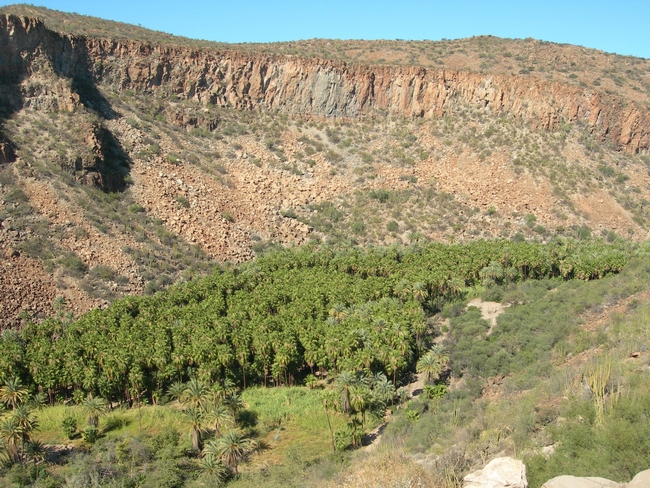Subtropics Snapshot: The Mexican Date Industry
Noé Ortiz-Uribe1, Ricardo Salomón-Torres1, Robert Krueger2
1Universidad Estatal de Sonora; 2USDA-ARS, Riverside, CA
The crop practices used in commercial date production in Mexico are mostly the same as those used in the United States, since the main growing areas in the U.S. are close to the San Luis and Mexicali Valleys and have similar climates and soils. Some companies have plantations in both countries.
Propagation is mainly by offshoots. The main cultivar, ‘Medjool', produces many offshoots. Propagation from tissue culture is uncommon at this time, although recently there have been some plantings of tissue culture-derived palms from the U.S. and Qatar. These have not yet been field tested for performance compared to offshoot plantings.
Fertilization is provided mainly for N-P-K. In sandy soils, fertilizer is delivered via irrigation systems, and amendments for improving soil water retention are widely used. Organic production areas are small, but slowly increasing. Various farms are being certified since the market of this category of products gives better prices for the organically grown dates. Plantation practices differ based on the irrigation technique. Limited water supply is forcing irrigation to turn to pressurized systems; however, flood irrigation is the main method of water delivery. Flood-irrigated fields are leveled with laser equipment. In sandy desert areas, where flood irrigation is impractical, no leveling is required, and the use of drip irrigation with pressure-compensated drippers allows small slopes and dunes in the production field. In Baja California Sur, irrigation in modern commercial plantations is delivered by dripping systems, whereas in Coahuila, only the flooding technique is used.
The process of pollination in commercial plantations is carried out artificially, while in the oases it is performed naturally by the wind. Pollination takes place once the inflorescence is open by late February or early March. For ‘Medjool', thinning of the bunch follows pollination. Some 15 to 20 flowering strands are cut from the center of the inflorescence in April and in May fruits are removed so that there is a separation of 1 inch between remaining ones, leaving 12 – 18 fruits per strand. This practice improves fruit quality and reduces alternate bearing. A concurrent activity to the thinning process consists of the tying of the bunch to the closest leaf in a position for easy access during the following activities. This supports the bunch and reduces the number of broken fruit stalks. Sacs of mesh fabric are placed covering the fruit raceme to avoid damage from birds and insects. This activity is carried out when the fruits turn to a yellow color at the khalal stage in July to August.
Pest presence on date palms in Mexico is not significant, but there are various potential threats. Insect pests, such as various species of nitidulid beetles, have been detected infesting ‘Medjool' dates in the Mexicali valley, and red mites can cause production losses. No research has yet been done to characterize the incidence of these pests in the region. The South American palm weevil, Rhynchophorus palmarum, has been detected in cities close to the production areas; therefore, a program for monitoring its potential presence is needed.
Date palm diseases in commercial production areas are not reported yet, but some plantations in both the San Luis Rio Colorado and Mexicali regions show a few palms with symptoms similar to those of Fusarium. Since this disease can be devastating to date palms, these palms need to be closely monitored. Additional information regarding potential disease problems needs to be developed for the Mexican date-producing areas.
Vertebrate pests of date palms include squirrels and gophers. A potential vertebrate pest not found in the U.S. is the monk parakeet (Myiopsitta monachus), which makes its nest on the palms and feeds on the dates. The monk parakeet has been observed in garden palms and other plants in areas near date production in both Sonora and Baja California.
Harvest of ‘Medjool' starts in August and finishes by October. Dates are harvested from the ground or by climbing into the crown with young, short trees. Harvest of taller trees uses forklifts fitted with circular platforms that are used to elevate the crews to crown. Date fruit are harvested into circular trays consisting of fishing net over a metal form, and then lowered to the ground and placed into 2-inch deep plastic trays.
The date growing industry has the potential to contribute to the economic development of the northwest of Mexico, since there are not many other regions in Mexico that can grow high quality dates. Date growers are improving date cultural practices, and it is very possible that yields increase from the current average of 7.9 ton/ha to 10 ton/ha in the next 5 years. The main obstacle for this industry is commercialization and export. Currently, there is only one integrated company that exports the packaged fruit to other countries. Training and financing are required so that small and medium producers are better organized and form co-ops for packing and marketing of their products. In order to stimulate internal consumption, it is necessary to widely disseminate the health benefits generated by the consumption of dates. It is necessary to carry out more research on date palms in order to improve the current methods of cultivation, to be prepared for possible future pests, work with practices to optimize the use of water, and develop new products derived from the date. Likewise, research to take advantage of date palm agricultural residues, such as the extraction of oil from the seed, or use as biofuel or livestock feed is needed.
Note: This article was adapted from a longer, refereed paper. Ortiz-Uribe N, Salomón-Torres R, Krueger R (2019) Date palm status and perspective in Mexico. Agriculture 9, 46. doi:10.3390/agriculture9030046
Read more at: http://ceventura.ucanr.edu/Com_Ag/Subtropical/
